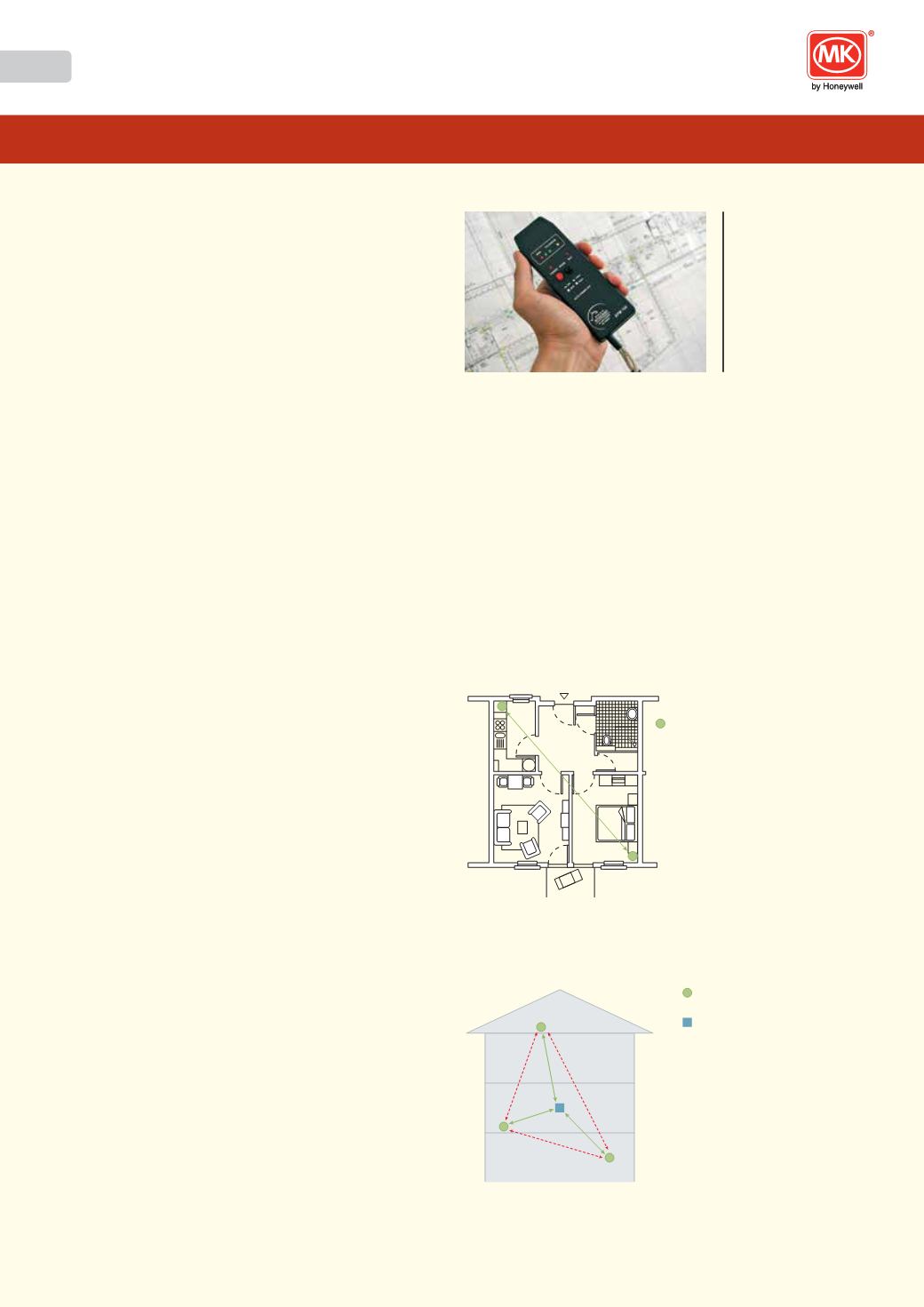

16
Echo™
Technical
wiring devices
|
wireless
www.mkelectric.co.uk8. FIELD STRENGTH INDICATOR
The K5419R is a mobile Field Strength Indicator enabling the installer to
determine the ideal mounting positions for Transmitters and Receivers.
Furthermore, faulty connections of devices already installed can be
checked. The unit shows the field intensities of radio signals received and
any interfering radio signals in the 868MHz range.
Using the Field Strength Indicator allows the installer to review the strength
of received signals at the proposed receiver locations – to ensure reliable
operation you should aim to have consistent GREEN or AMBER signals
on the indicator.
The meaning of the four LEDs at the top section of the Field Strength
Indicator, are as follows:
l
The right hand AMBER LED is headed “Telegram Valid”. This
signifies that an 868MHz signal has been detected.
l
The left hand RED LED signifies that the signal strength is insufficient
for a good installation. This LED will be illuminated immediately when
the Power button is switched on.
l
The AMBER “Class A” LED signifies that the installation will be
good. The only proviso to this is that the Switch Receiver is not to be
recessed in the wall or have any further potential screening situated
around it, which could further increase signal attenuation.
l
GREEN, the “Class B” LED, ensures an excellent installation, even if
there is a little further screening caused, for instance by mounting it
below a wall surface, assuming this is not in a metal box.
To get the best results, always hold the Transmitter exactly where it is
intended to be installed and place the Field Strength Indicator exactly
where the Receiver will be installed.
When the Transmitter is operated and the GREEN LED is illuminated, this
signals that the receiving field force possesses sufficient power reserve
for a reliable installation. There will be generous provision for subsequently
changing conditions of the surroundings (i.e. additional screening caused
by lightweight walls, shadowing by people etc.).
If the signal received is AMBER, repeat the test three times. If three
AMBERS or a mixture of AMBER and GREEN are received, the installation
will be good. The only proviso to this is that the Receiver is not to be
recessed in the wall or further screened in any way, which in itself would
increase any signal attenuation.
If just the RED LED is illuminated, this indicates that the present intended
installation is not acceptable.
If the signal is not good enough in the initial layout, consider rearranging
the position of the Switch Receiver to see if the signal strength can be
improved.
How to use the Field Strength Indicator:
Person 1 operates the Transmitter and generates the radio signal by
pressing the switch. Person 2 checks the field strength received on the
display of the device and thus determines the ideal position.
Alternatively, if conducting the investigation alone, press the “1 min.”
button on the Field Strength Indicator, then from the moment of pressing
the Transmitter, you have that long to return to the indicator to determine
the suitability of the proposed installation.
.
The Field Strength Indicator can be used for on-site determination of
the ideal mounting position of the Transmitter and for identification of an
interfering radio signal.
Even after careful planning, the Field Strength Indicator should be used to
verify proper reception at the Switch Receiver position during installation.
9. PLANNING INFORMATION FOR RESIDENTIAL BUILDINGS
For applications restricted to one or two rooms, e.g. when retrofitting a
switch, the direct transmission range will normally be adequate. For
applications “throughout” a building, the following differentiations must be
made:
Flats, terraced houses and single-family houses of up to 400sqm.
l
Larger residential units with 3 rooms or more (living room and
bedrooms) should be fitted with a Repeater. The Repeater should be
centrally placed (e.g. in the centre of the middle floor).
Small residential unit (up to 3 walls and 1 ceiling)
Transmitter
or Receiver
Bedsit or up to 2 floors in a townhouse: the direct transmission range is
usually adequate.
Multi-room flat and one-family house (more than 3 walls, more than
1 ceiling)
Transmitter
or Receiver
Repeater
To ensure radio coverage in a larger residential unit, it is generally
advisable to install a central Repeater.
Echo™ is a registered trademark of Novar ED&S Limited
Field Strength
Indicator K5419R



















